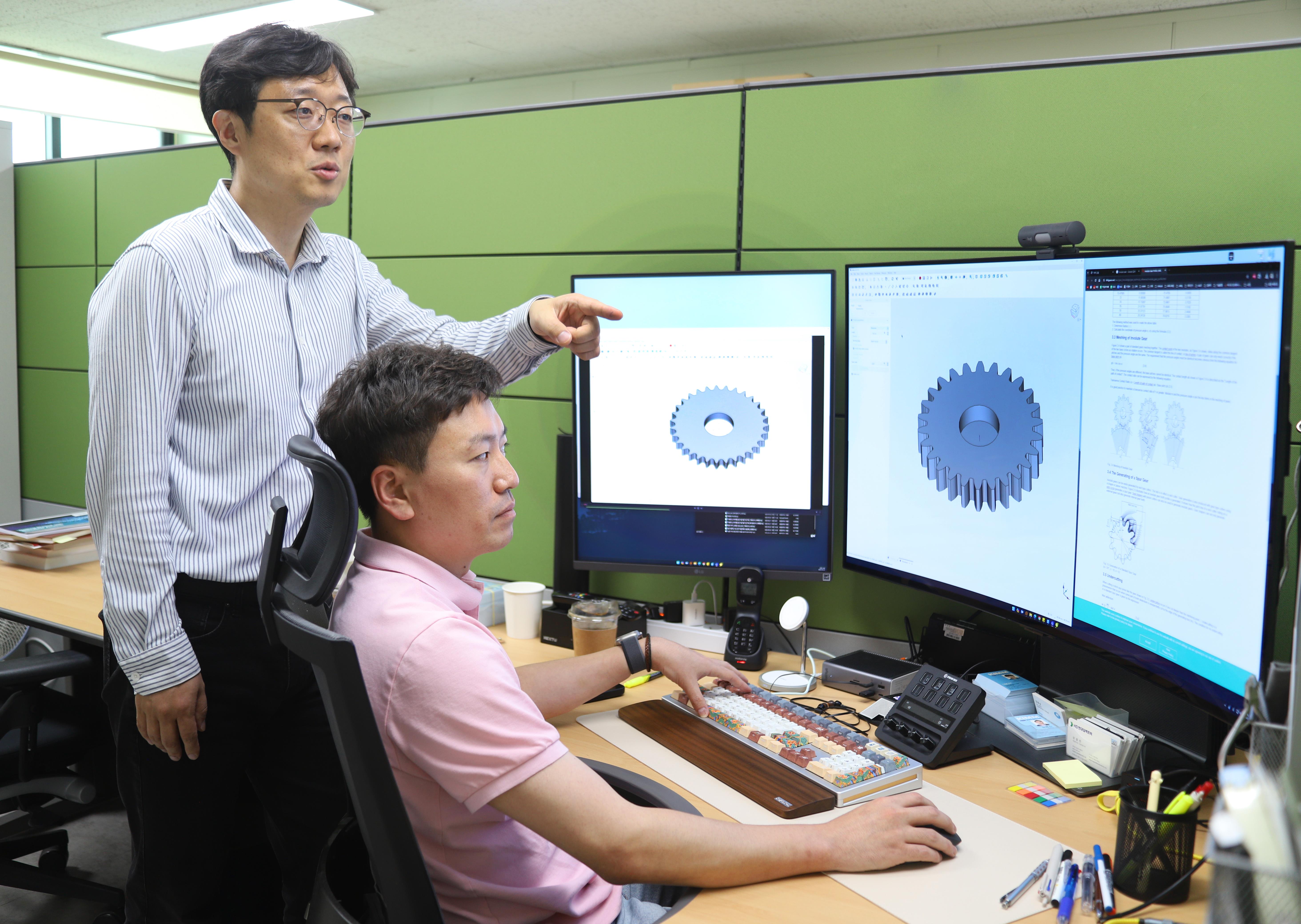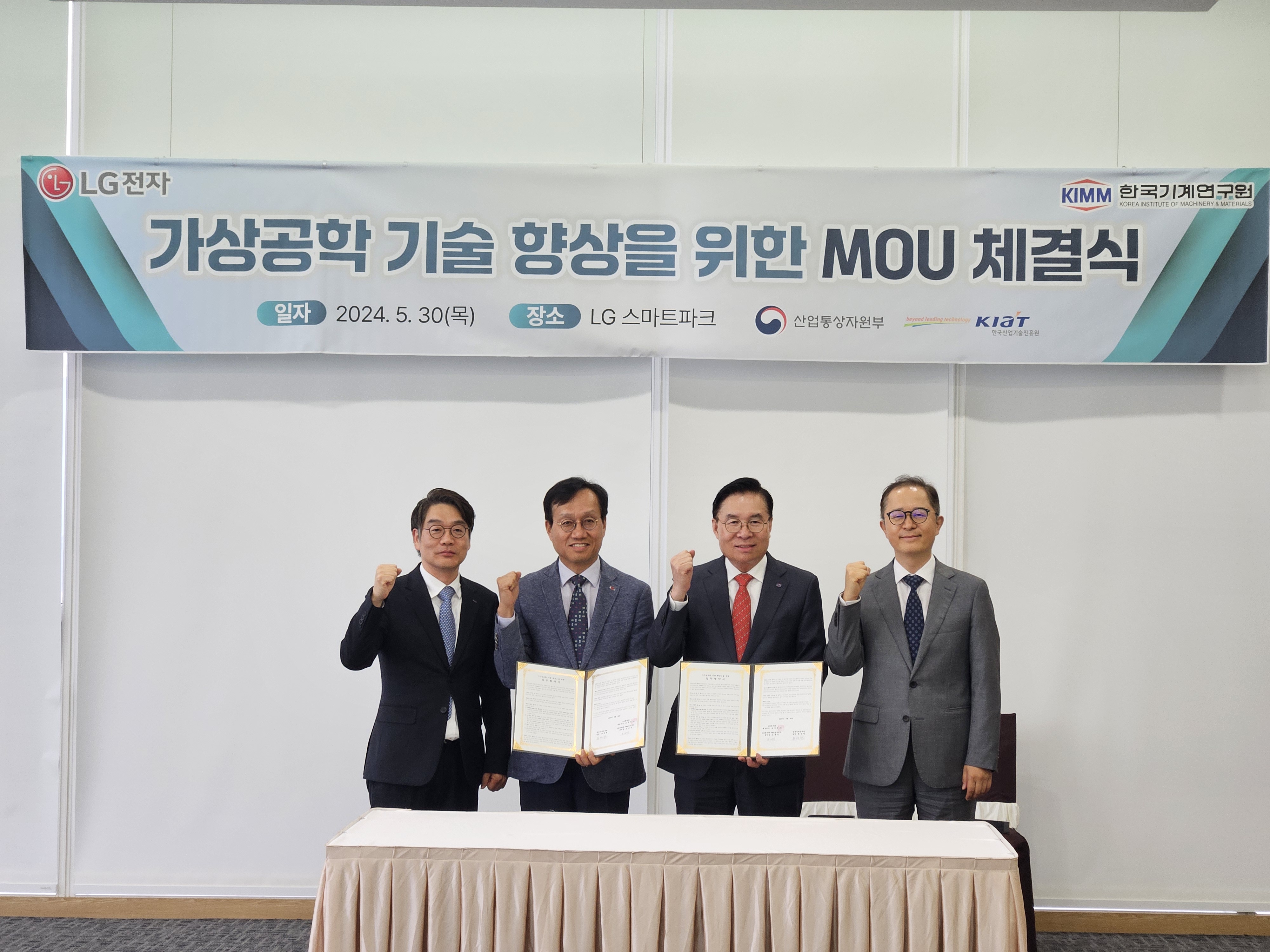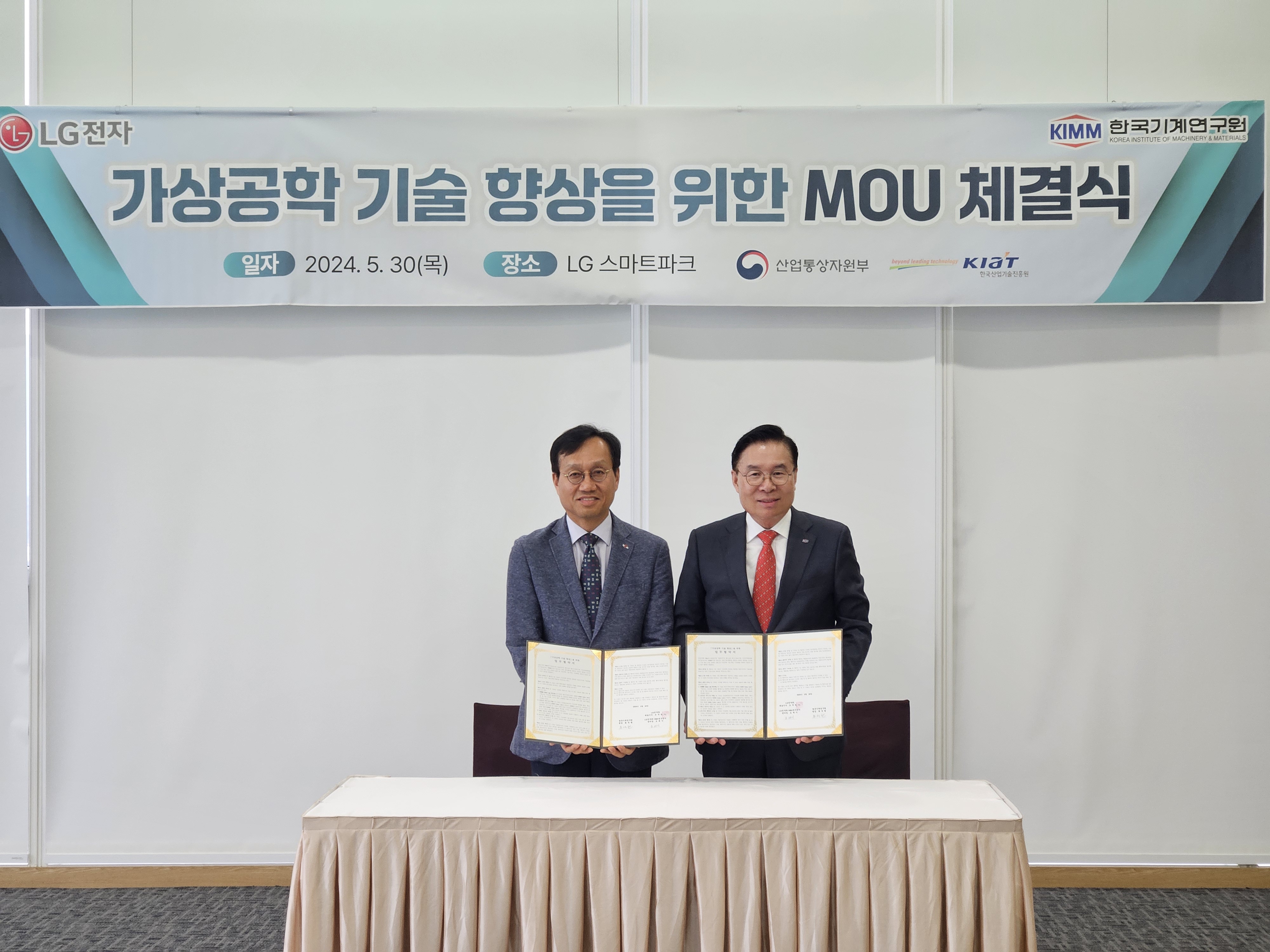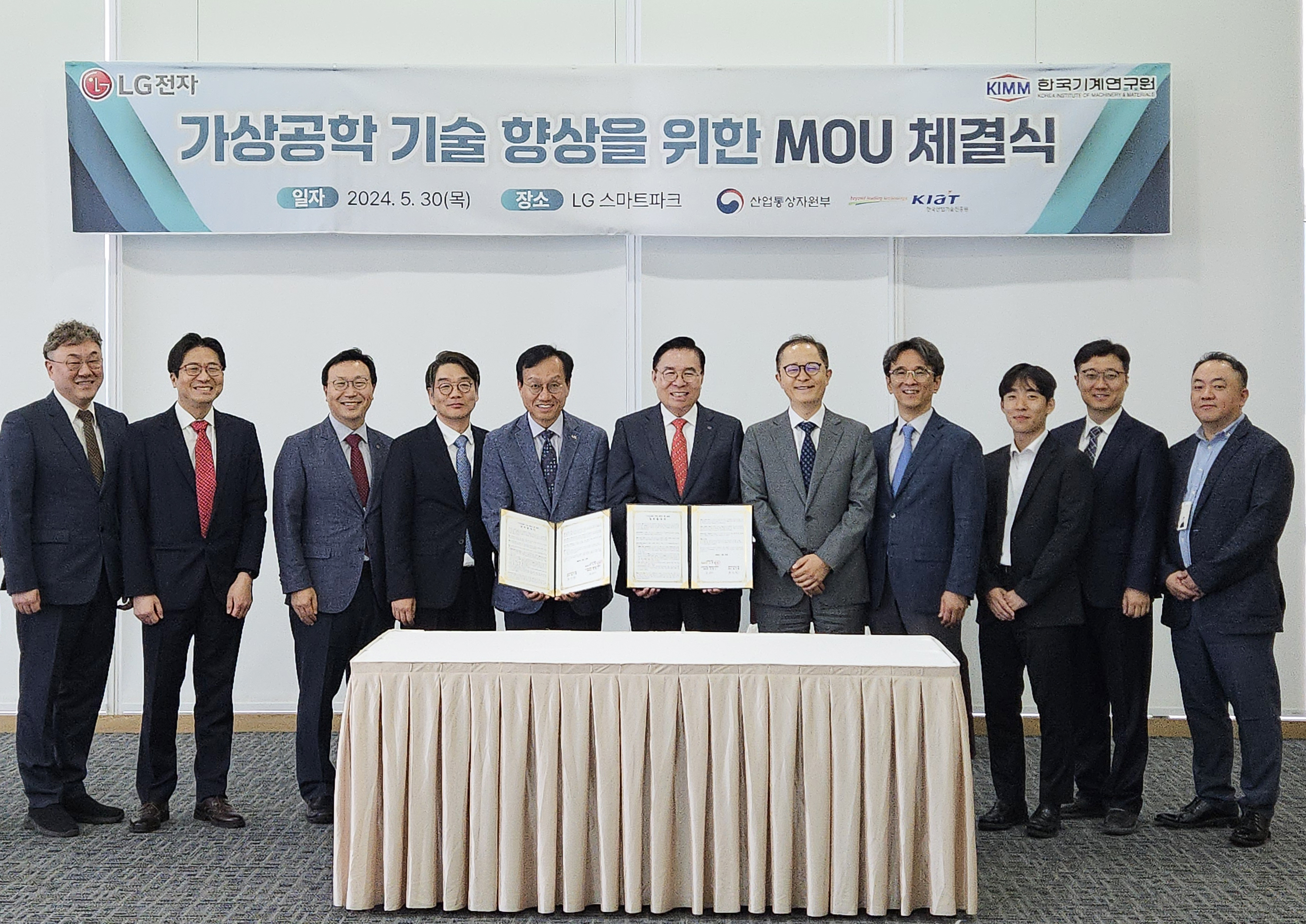
- Created2024.05.30
“Anyone can make products easily in virtual reality” KIMM and LG Electronics join hands to assist the digital transformation of Korean small and medium-sized enterprises
- KIMM plans to distribute six (6) variants of “KIMM Cyber Lab,” a convenient virtual engineering platform, to small and medium-sized corporations free of charge
- KIMM and LG Electronics to sign an MOU for the utilization and proliferation of virtual engineering platforms
□ Virtual engineering technology, a critical component of digital transformation, involves using technology to conduct simulation experiments and manufacture products in a virtual setting, which helps save time and costs. In this context, the Korea Institute of Machinery and Materials (President Seog-Hyeon Ryu, hereinafter referred to as KIMM) is leading the way in expanding its newly developed “virtual engineering platform*” to promote digital transformation among small and medium-sized enterprises that are less advanced in virtual engineering technologies.
*Virtual engineering platform: A virtual engineering platform is a comprehensive software system designed for a range of tasks including design, simulation, analysis, and optimization tasks performed in a virtual environment in the engineering and manufacturing sectors.

<Dong-Cheon Baek, head of the Dept. of Reliability of KIMM, and Senior Researcher Young-Ki Kim giving an explanation on the “KIMM-CAD” which allows for 3D designing>
□ The initiative is spearheaded by the research team led by Jong-Won Park, head of DX Strategy Reaserch Center, and Dong-Cheon Baek, head of the Department of Reliability at KIMM’s Virtual Engineering Platform Research Division. The team has effectively developed six (6) variants of the “KIMM Cyber Lab,” a versatile engineering software* program. This program features “KIMM-CAD” for 3D design, “KIMM-Structure” for structural analysis, “KIMM-Flow” for flow analysis, “KIMM-CAM” for CNC path creation, “KIMM-Motion” for multi-body dynamics simulation**, and “KIMM-SYS” for system interpretation.
*Engineering software: An engineering software is a computer program used for performing design, analysis, and simulation tasks in various engineering disciplines.
**Multi-body dynamics simulation: Multi-body dynamics simulation is an engineering method used for predicting the movement of interconnected parts and modules.
□ Despite the critical role of engineering software in the manufacturing processes of Korean machinery parts manufacturers, about 90 percent of this software is imported. Consequently, small and medium-sized enterprises are hesitant to invest in costly foreign engineering software, the cost of which exceeds KRW 50 million annually*. This reluctance significantly impedes the digital transformation of these companies.
*The cost to introduce one (1) software is approximately KRW 100 million, with an annual repair and maintenance cost ranging from KRW 30 million to 40 million. The software typically has a usage period of five (5) years, bringing the total cost to KRW 250 million over this period.

□ The open-source solver* which includes six (6) variants of the “KIMM Cyber Lab” developed by KIMM is freely usable and distributable under its licensing terms. This is poised to significantly advance the digital transformation of Korean small and medium-sized enterprises. To date, KIMM has assisted companies on 214 occasions, saving an average of KRW 16 million in development costs and reducing the development timeline by approximately three (3) months.
*Solver: A solver is an algorithm or software designed to solve problems by optimizing a goal within the given constraints.
□ The “KIMM Cyber Lab” software performs with 95 percent accuracy, matching the capabilities of costly foreign software. It will be distributed free of charge to small and medium-sized enterprises. Going forward, KIMM intends to introduce an annual subscription fee for companies requiring ongoing technical support.
□ This research was facilitated by the virtual engineering platform construction project of the Ministry of Trade, Industry and Energy (MOTIE) and the Korea Institute for Advancement of Technology (KIAT). The project focuses on the “establishment of a theme for reliability prediction and verification of electric and hydrogen vehicle mechatronics modules using digital twin three-stage technologies.”

<After signing an MoU, KIMM President Seog-Hyeon Ryu (second from the right) and LG Electronics's Director Sai-Kee Oh (second from the left)
taking a group photo with the MOTIE's Industrial Policy Deputy Minister Seung-Ryeol Lee (first from the right) and Vice President Can-Young Lee of KIAT (first from the left)>


<KIMM has signed an MoU with the LG Electronics’ H&A Research Center on May 30, 2024 (Thu.) for the utilization and expansion of virtual engineering platforms>
□ Meanwhile, on May 30, 2024 (Thursday), at LG Smart Park located in Changwon-si, Gyeongsangnam-do, KIMM will sign a memorandum of understanding (MOU) with the LG Electronics’ H&A Research Center (Director Sai-Kee Oh) for the utilization and expansion of virtual engineering platforms, with Industry Policy Deputy Minister Seung-Ryeol Lee of MOTIE and Vice President Chan-Young Lee of KIAT attending the signing ceremony. KIMM and LG Electronics have agreed to introduce the “KIMM Cyber Lab” and continue mutual cooperation to bolster the competitiveness of the domestic machinery industry and accelerate technological innovation for digital transformation.
□ The key points of the MOU are as follows: ▲ Joint verification and technology advancement of the “KIMM Cyber Lab” for the improvement of virtual engineering technologies; ▲ Development of best practices for the provision of customized solutions for industrial sites; and ▲Mutual sharing and maintenance of confidentiality of the information necessary for the application of the “KIMM Cyber Lab.”
□ President Seog-Hyeon Ryu of KIMM remarked, “This initiative presents an excellent opportunity to promote the adoption of locally developed software by first integrating it within major corporations. Subsequently, this will facilitate the distribution of the software to small and medium-sized enterprises in the materials, parts, and equipment sectors via a trickle-down effect.” President Ryu further noted, “Through our collaboration with the LG Electronics, we are committed to fostering a symbiotic relationship that also benefits small and medium-sized businesses.”


